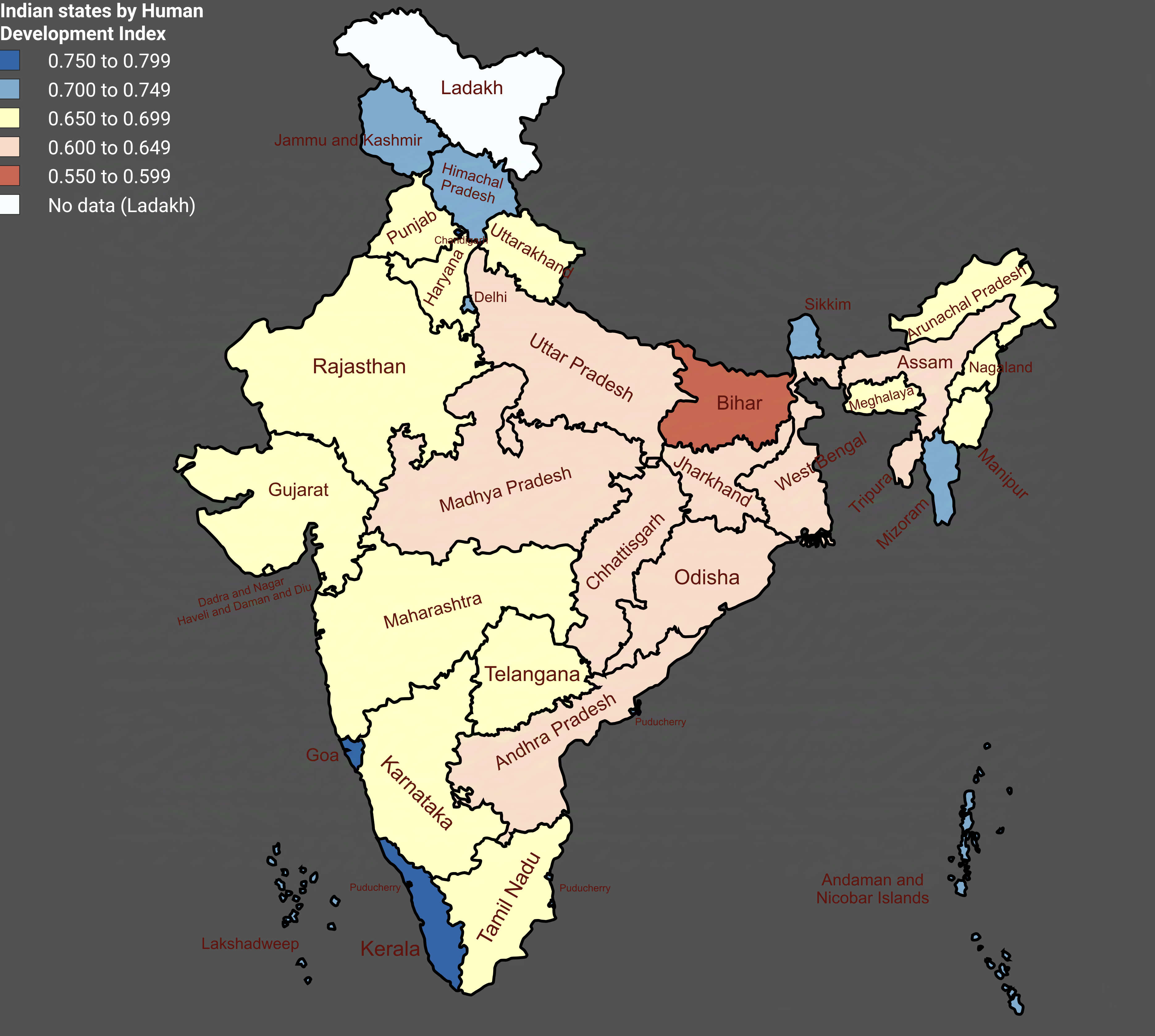Indian States by Human Development Index Map


Marcus Rodriguez
Historical Geography Expert
Marcus Rodriguez specializes in historical cartography and geographic data analysis. With a background in both history and geography, he brings unique...
Geographic Analysis
What This Map Shows
The "Indian States by Human Development Index Map" vividly illustrates the varying levels of human development across India's diverse states. The Human Development Index (HDI) is a composite statistic of life expectancy, education, and per capita income indicators, which are used to rank countries and regions into four tiers of human development. By visualizing HDI at the state level, we can gain insights into the social and economic conditions that affect millions of lives across the country.
Deep Dive into Human Development Index
The Human Development Index, developed by the United Nations Development Programme (UNDP), serves as a crucial tool for understanding the well-being of individuals in different regions. It's fascinating to note that the HDI goes beyond mere economic indicators; it encapsulates quality of life through education and health, providing a more holistic view of development.
For instance, the states of Kerala and Delhi often stand out with high HDI scores, reflecting their robust educational systems and healthcare facilities. Kerala, known for its strong emphasis on education and healthcare, boasts a literacy rate of over 96% and one of the highest life expectancy rates in the country. Conversely, states such as Bihar and Uttar Pradesh tend to have lower HDI scores, primarily due to challenges in education and healthcare access. Bihar, for example, struggles with a literacy rate of around 61%, impacting its overall HDI ranking.
Interestingly, the disparities in HDI scores often correlate with historical, cultural, and economic factors. States that have historically prioritized education and social welfare tend to perform better on the HDI scale. Moreover, urbanization plays a significant role; as cities expand, they often provide better access to services and employment opportunities, thus enhancing the human development metrics. Areas like Maharashtra and Gujarat have seen rapid urban growth, which has contributed positively to their HDI rankings.
The HDI is not static; it evolves over time as states implement policies aimed at improving the quality of life for their residents. For example, initiatives in Andhra Pradesh to enhance educational infrastructure and healthcare access have shown promising results, leading to gradual improvements in its HDI. On the other hand, states that face political instability or economic downturns may see stagnation or decline in their HDI, reflecting the intricate link between governance, policy, and human development.
Regional Analysis
When we break down the map into regions, distinct patterns emerge. The southern states, including Tamil Nadu, Kerala, and Karnataka, consistently rank higher on the HDI scale. Tamil Nadu, for example, benefits from a well-established manufacturing sector and a focus on education, resulting in a comparatively high HDI. Conversely, the north-central states, including Madhya Pradesh and Uttar Pradesh, often lag behind, primarily due to historical socio-economic challenges and lower investment in human capital.
In the northeastern region, states like Mizoram and Nagaland showcase higher HDI levels compared to their peers, driven by community-focused governance and social cohesion. However, despite their advantages, these states face unique challenges, such as geographical isolation and limited access to larger markets, which can impede further development.
The western region, particularly Maharashtra and Gujarat, exhibits a mix of high HDI due to economic dynamism and urbanization, yet they also experience significant rural-urban divides. While cities like Mumbai and Ahmedabad thrive, rural areas may not share in the same level of development, underscoring the need for balanced policies that promote inclusive growth.
Significance and Impact
Understanding the Human Development Index and the disparities among Indian states is crucial for policymakers, researchers, and citizens alike. It’s not just about numbers; these figures represent real lives and their potential for improvement. Recognizing which states are thriving and which are struggling can inform targeted interventions, ensuring that resources are allocated where they’re needed most.
The implications of HDI extend beyond mere statistics; they influence migration patterns, economic opportunities, and social dynamics. For example, high HDI states often attract skilled labor, while lower HDI states may face out-migration, leading to a brain drain that further exacerbates their challenges.
As we look toward the future, the focus on human development is becoming increasingly critical. With global challenges such as climate change, economic inequality, and health crises, understanding and addressing the factors that contribute to human development will be essential for creating a sustainable and equitable society. The ongoing efforts to improve HDI across Indian states could pave the way for a more prosperous nation, where each individual has the opportunity to thrive.
The HDI map serves as a reminder of the work that lies ahead. Have you ever considered how local policies can influence your quality of life? As we engage with this data, it’s important to reflect on the broader implications for not just the present but also for future generations.
Visualization Details
- Published
- October 19, 2025
- Views
- 30
Comments
Loading comments...